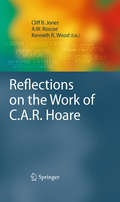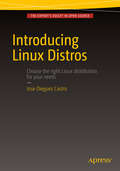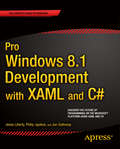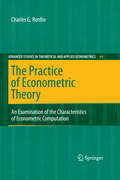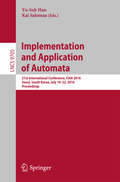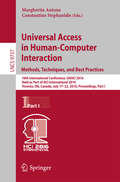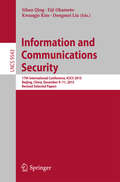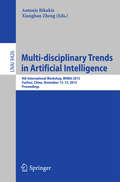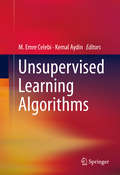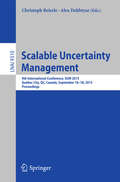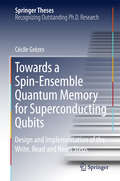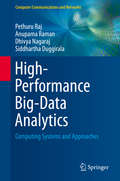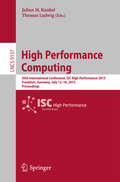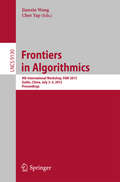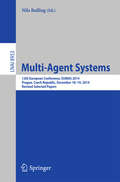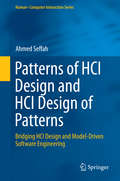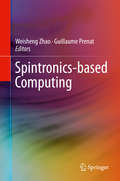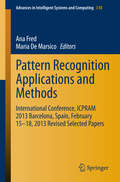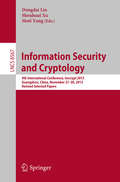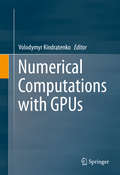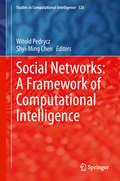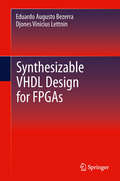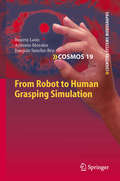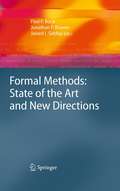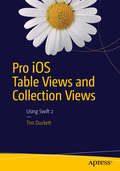- Table View
- List View
Reflections on the Work of C.A.R. Hoare
by A. W. Roscoe Kenneth R. Wood Cliff B. JonesThousands of different programming languages exist, and many more are being created each year, yet all those involved in such work must acknowledge that it is "the highest goal of programming language design to enable good ideas to be elegantly expressed". These are the words of Sir Charles Antony Richard Hoare, or Tony Hoare to his colleagues and friends, a man who has inspired generations of researchers in computer science. His work, grounded in practical programming, has had a profound impact on the evolution of the field. This includes the development of Hoare logic and Communicating Sequential Processes (CSP). Reflections on the Work of C.A.R. Hoare presents a comprehensive edited survey of all aspects of these subjects, with original contributions by more than 30 international leaders in the field. The book, while honoring Hoare's important contributions, assembles a collection of chapters showing the state of the art in programming languages, sequential programs, concurrency, and unified theories of programming. Topics and features: demonstrates a principled combination of CSP and functional programming, and the expression of CSP semantics to π-calculus; reviews methods for proving Hoare formulae based on the computation of postconditions and preconditions; investigates developments in game semantics and semantics based on the state monad; examines the satisfiability problem, void safety, and issues of auxiliary variables; introduces type families in Haskell and a description of Quicksort in Orc; describes an experiment using the Tokeneer archive, and a correctness proof of cryptographic protocols based on the Shadow Security model; presents a representation of CSP as a bigraphical reactive system, and shows how simple entities can be related to CSP processes; discusses the problem frames approach, and explores algebraic properties of the new programming combinators. This accessible monograph is an ideal overview of theoretical and empirical evolution in programming logic and semantics of programming languages. It will serve as an invaluable resource for professionals, researchers, libraries, and students who are interested in broadening their knowledge in all of the areas covered.
Introducing Linux Distros
by Jose Dieguez CastroThe first barrier that a new Linux user has to face is the overwhelming number of "flavors" that this operating system has. These "flavors" are commonly known as distros (from distribution), and to date there are more than three hundred active distros to choose from. So, how to choose one? You can choose the most popular at the moment, or take heed of what your friend says, but are you sure that this is the one that you need? Making the wrong decision on this matter is behind a good number of disappointments with this operating system. You need to choose the distro that is right for you and your needs. Introducing Linux Distros teaches you the pros and the cons of the most frequently used distros in order to find the one that is right for you. You will explore each distro step by step, so that you don't have to endure hours of web surfing, countless downloads, becoming confused by new concepts and, in the worst cases, reading complex and marathon installation guides. You will benefit from the author's long-term experience working with each distro hands on, enabling you to choose the best distro for your long-term needs. Linux offers us a wonderful open source alternative to proprietary software, and using Introducing Linux Distros you can decide how to best make it work for you. Start exploring the open source world today. What you'll learn What a Linux distro is and why are some many Which criteria you need to follow to make a right decision Which "family trees" of Linux Distros exist The most used Linux distros and their unique "philosophy" The pros and cons of those distros How to install a good number of Linux distros Which tasks are needed to "maintain" those Linux installations working How get support for each distro Who this book is for Introducing Linux Distros is for the newcomer to the Linux world that has to deal with myriad distributions to make a first and crucial decision: what Linux Distro to use? This book will help anyone find the distro that best fits your needs, and make your Linux debut a smoother one.
Pro Windows 8.1 Development with XAML and C#
by Jesse Liberty Jon Galloway Philip JapikseWindows 8. 1 apps are revolutionizing development on the Windows platform. Fast, fluid, tactile and chrome-free, they provide a brand-new look and feel for Windows users. These apps rely on Microsoft's Windows 8 modern UI to provide their rich and engaging user experiences for both desktop and tablet users. The new UI in turn relies upon the Windows Runtime (WinRT) to give its apps unparalleled flexibility and power. Understanding this stack of new technologies and how they tie in to the proven C# language and the XAML standard is the subject of this book. Experienced writers Jesse Liberty, Phil Japikse, and Jon Galloway explain how you can get the most from Windows 8. 1 by focusing on the features that you need for your project and bringing your existing C# coding knowledge to bear. They begin with a nuts-and-bolts examination of how the technologies fit together and show you everything you need to get up and running with the new platform. Once you have a good understanding on the basics, you progress to more advanced topics steadily increasing your understanding as a whole. This holistic knowledge is essential to truly master Windows 8. 1 development. Each topic is covered clearly and concisely and is packed with the details you need to code effectively. The most important features are given a no-nonsense, in-depth treatment and chapters contain examples that demonstrate both the power and the subtlety of Windows 8. 1. What you'll learnWhat Metro and WinRT are capable of and why they are special Ways to use advanced features to create immersive and engaging Windows 8. 1 applications How to create applications that work seamlessly on tablets and desktops How to prepare and deploy your Windows 8. 1 applications Who this book is for This book is suitable for anyone wanting to get to grips with Windows 8. 1 development using the cross-platform standards of XAML and C#. Table of Contents1 Getting Started 2 Building Your First Windows 8 App 3 Themes, Panels, and Controls4 Binding5 Views6 Local Data7 Remote Data and Services8 Search and Share Contracts9 Notifications10 Application Life Cycle11 Making Money12 Publishing Your App"
The Practice of Econometric Theory
by Charles G. RenfroEconometric theory, as presented in textbooks and the econometric literature generally, is a somewhat disparate collection of findings. Its essential nature is to be a set of demonstrated results that increase over time, each logically based on a specific set of axioms or assumptions, yet at every moment, rather than a finished work, these inevitably form an incomplete body of knowledge. The practice of econometric theory consists of selecting from, applying, and evaluating this literature, so as to test its applicability and range. The creation, development, and use of computer software has led applied economic research into a new age. This book describes the history of econometric computation from 1950 to the present day, based upon an interactive survey involving the collaboration of the many econometricians who have designed and developed this software. It identifies each of the econometric software packages that are made available to and used by economists and econometricians worldwide.
Implementation and Application of Automata
by Yo-Sub Han Kai SalomaaThis book constitutes the refereed proceedings of the 21st InternationalConference on Implementation and Application of Automata, CIAA 2016, held in Seoul, South Korea, in July 2016. The 26 revised full papers presented were carefully reviewed and selected from49 submissions. The papers cover a wide range of topics including characterizations of automata, computing distances between strings and languages, implementations ofautomata and experiments, enhanced regular expressions, and complexity analysis.
Universal Access in Human-Computer Interaction. Methods, Techniques, and Best Practices
by Margherita Antona Constantine StephanidisThe three-volume set LNCS 9737-9739 constitutes the refereed proceedings of the 10th International Conference on Universal Access in Human-Computer Interaction, UAHCI 2016, held as part of the 10th International Conference on Human-Computer Interaction, HCII 2016, in Toronto, ON, Canada in July 2016, jointly with 15 other thematically similar conferences. The total of 1287 papers presented at the HCII 2016 conferences were carefully reviewed and selected from 4354 submissions. The papers included in the three UAHCI 2016 volumes address the following major topics: novel approaches to accessibility; design for all and eInclusion best practices; universal access in architecture and product design; personal and collective informatics in universal access; eye-tracking in universal access; multimodal and natural interaction for universal access; universal access to mobile interaction; virtual reality, 3D and universal access; intelligent and assistive environments; universal access to education and learning; technologies for ASD and cognitive disabilities; design for healthy aging and rehabilitation; universal access to media and games; and universal access to mobility and automotive.
Information and Communications Security
by Sihan Qing Eiji Okamoto Kwangjo Kim Dongmei LiuThis book constitutes the thoroughly refereed post-conference proceedings of the 17th International Conference on Information and Communications Security, ICISC 2015, held in Beijing, China, in December 2015. The 24 revised full papers and 19 short papers presented were carefully selected from 148 submissions. The papers provide the latest results in research and development in the field of information security and applied cryptology.
Multi-disciplinary Trends in Artificial Intelligence
by Xianghan Zheng Antonis BikakisThis book constitutes the refereed conference proceedings of the 9th International Conference on Multi-disciplinary Trends in Artificial Intelligence, MIWAI 2015, held in Fuzhou, China, in November 2015. The 30 revised full papers presented together with 12 short papers were carefully reviewed and selected from 83 submissions. The papers feature a wide range of topics covering knowledge representation, reasoning, and management; multi-agent systems; data mining and machine learning; computer vision; robotics; AI in bioinformatics; AI in security and networks; and other AI applications.
Unsupervised Learning Algorithms
by M. Emre Celebi Kemal AydinThis book summarizes the state-of-the-art in unsupervised learning. The contributors discuss how with the proliferation of massive amounts of unlabeled data, unsupervised learning algorithms, which can automatically discover interesting and useful patterns in such data, have gained popularity among researchers and practitioners. The authors outline how these algorithms have found numerous applications including pattern recognition, market basket analysis, web mining, social network analysis, information retrieval, recommender systems, market research, intrusion detection, and fraud detection. They present how the difficulty of developing theoretically sound approaches that are amenable to objective evaluation have resulted in the proposal of numerous unsupervised learning algorithms over the past half-century. The intended audience includes researchers and practitioners who are increasingly using unsupervised learning algorithms to analyze their data. Topics of interest include anomaly detection, clustering, feature extraction, and applications of unsupervised learning. Each chapter is contributed by a leading expert in the field.
Scalable Uncertainty Management
by Christoph Beierle Alex DekhtyarThis book constitutes the refereed proceedings of the 9th International Conference on Scalable Uncertainty Management, SUM 2015, held in Québec City, QC, Canada, in September 2015. The 25 regular papers and 3 short papers were carefully reviewed and selected from 49 submissions. The call for papers for SUM 2015 solicited submissions in all areas of managing and reasoning with substantial and complex kinds of uncertain, incomplete or inconsistent information. These include applications in decision support systems, risk analysis, machine learning, belief networks, logics of uncertainty, belief revision and update, argumentation, negotiation technologies, semantic web applications, search engines, ontology systems, information fusion, information retrieval, natural language processing, information extraction, image recognition, vision systems, data and text mining, and the consideration of issues such as provenance, trust, heterogeneity, and complexity of data and knowledge.
Towards a Spin-Ensemble Quantum Memory for Superconducting Qubits
by Cécile GrèzesThis work describes theoretical and experimental advances towards the realization of a hybrid quantum processor in which the collective degrees of freedom of an ensemble of spins in a crystal are used as a multi-qubit register for superconducting qubits. A memory protocol made of write, read and reset operations is first presented, followed by the demonstration of building blocks of its implementation with NV center spins in diamond. Qubit states are written by resonant absorption of a microwave photon in the spin ensemble and read out of the memory on-demand by applying Hahn echo refocusing techniques to the spins. The reset step is implemented in between two successive write-read sequences using optical repumping of the spins.
High-Performance Big-Data Analytics
by Pethuru Raj Anupama Raman Dhivya Nagaraj Siddhartha DuggiralaThis book presents a detailed review of high-performance computing infrastructures for next-generation big data and fast data analytics. Features: includes case studies and learning activities throughout the book and self-study exercises in every chapter; presents detailed case studies on social media analytics for intelligent businesses and on big data analytics (BDA) in the healthcare sector; describes the network infrastructure requirements for effective transfer of big data, and the storage infrastructure requirements of applications which generate big data; examines real-time analytics solutions; introduces in-database processing and in-memory analytics techniques for data mining; discusses the use of mainframes for handling real-time big data and the latest types of data management systems for BDA; provides information on the use of cluster, grid and cloud computing systems for BDA; reviews the peer-to-peer techniques and tools and the common information visualization techniques, used in BDA.
High Performance Computing
by Thomas Ludwig Julian M. KunkelThis book constitutes the refereed proceedings of the 30th International Conference, ISC High Performance 2015, [formerly known as the International Supercomputing Conference] held in Frankfurt, Germany, in July 2015. The 27 revised full papers presented together with 10 short papers were carefully reviewed and selected from 67 submissions. The papers cover the following topics: cost-efficient data centers, scalable applications, advances in algorithms, scientific libraries, programming models, architectures, performance models and analysis, automatic performance optimization, parallel I/O and energy efficiency.
Frontiers in Algorithmics
by Jianxin Wang Chee YapThis book constitutes the proceedings of the 9th International Workshop on Frontiers in Algorithmics, FAW 2015, held in Guilin, China, in July 2015. The 28 papers presented in this volume were carefully reviewed and selected from 65 submissions. They deal with graph algorithms, approximation algorithms, combinatorial optimization, parameterized algorithms, and online algorithms.
Multi-Agent Systems
by Nils BullingThis book constitutes the proceedings of the 12th European Conference on Multi-Agent Systems, EUMAS 2014, held in Prague, Czech Republic, in December 2014. The 21 full papers and 8 short papers presented in this volume were carefully reviewed and selected from 79 submissions. They are organized in topical sections named: agent-based models, trust and reputation; coordination, coalitions and teamwork; logic and formal approaches; theories in practice and real-world problems; decision making, conflicts and agreements.
Patterns of HCI Design and HCI Design of Patterns
by Ahmed SeffahAs interactive systems are quickly becoming integral to our everyday lives, this book investigates how we can make these systems, from desktop and mobile apps to more wearable and immersive applications, more usable and maintainable by using HCI design patterns. It also examines how we can facilitate the reuse of design practices in the development lifecycle of multi-devices, multi-platforms and multi-contexts user interfaces. Effective design tools are provided for combining HCI design patterns and User Interface (UI) driven engineering to enhance design whilst differentiating between UI and the underlying system features. Several examples are used to demonstrate how HCI design patterns can support this decoupling by providing an architectural framework for pattern-oriented and model-driven engineering of multi-platforms and multi-devices user interfaces. Patterns of HCI Design and HCI Design of Patterns is for students, academics and Industry specialists who are concerned with user interfaces and usability within the software development community.
Spintronics-based Computing
by Weisheng Zhao Guillaume PrenatThis book provides a comprehensive introduction to spintronics-based computing for the next generation of ultra-low power/highly reliable logic. It will cover aspects from device to system-level, including magnetic memory cells, device modeling, hybrid circuit structure, design methodology, CAD tools, and technological integration methods. This book is accessible to a variety of readers and little or no background in magnetism and spin electronics are required to understand its content. The multidisciplinary team of expert authors from circuits, devices, computer architecture, CAD and system design reveal to readers the potential of spintronics nanodevices to reduce power consumption, improve reliability and enable new functionality.
Pattern Recognition Applications and Methods
by Ana Fred Maria De MarsicoThis book contains the extended and revised versions of a set of selected papers from the 2nd International Conference on Pattern Recognition (ICPRAM 2013), held in Barcelona, Spain, from 15 to 18 February, 2013. ICPRAM was organized by the Institute for Systems and Technologies of Information, Control and Communication (INSTICC) and was held in cooperation with the Association for the Advancement of Artificial Intelligence (AAAI). The hallmark of this conference was to encourage theory and practice to meet in a single venue. The focus of the book is on contributions describing applications of Pattern Recognition techniques to real-world problems, interdisciplinary research, experimental and/or theoretical studies yielding new insights that advance Pattern Recognition methods.
Information Security and Cryptology
by Moti Yung Dongdai Lin Shouhuai XuThis book constitutes the thoroughly refereed post-conference proceedings of the 9th International Conference on Information Security and Cryptology, Inscrypt 2013, held in Guangzhou, China, in November 2013. The 21 revised full papers presented together with 4 short papers were carefully reviewed and selected from 93 submissions. The papers cover the topics of Boolean function and block cipher, sequence and stream cipher, applications: systems and theory, computational number theory, public key cryptography, has function, side-channel and leakage, and application and system security.
Numerical Computations with GPUs
by Volodymyr KindratenkoThis book brings together research on numerical methods adapted for Graphics Processing Units (GPUs). It explains recent efforts to adapt classic numerical methods, including solution of linear equations and FFT, for massively parallel GPU architectures. This volume consolidates recent research and adaptations, covering widely used methods that are at the core of many scientific and engineering computations. Each chapter is written by authors working on a specific group of methods; these leading experts provide mathematical background, parallel algorithms and implementation details leading to reusable, adaptable and scalable code fragments. This book also serves as a GPU implementation manual for many numerical algorithms, sharing tips on GPUs that can increase application efficiency. The valuable insights into parallelization strategies for GPUs are supplemented by ready-to-use code fragments. Numerical Computations with GPUs targets professionals and researchers working in high performance computing and GPU programming. Advanced-level students focused on computer science and mathematics will also find this book useful as secondary text book or reference.
Social Networks: A Framework of Computational Intelligence
by Witold Pedrycz Shyi-Ming ChenThis volume provides the audience with an updated, in-depth and highly coherent material on the conceptually appealing and practically sound information technology of Computational Intelligence applied to the analysis, synthesis and evaluation of social networks. The volume involves studies devoted to key issues of social networks including community structure detection in networks, online social networks, knowledge growth and evaluation, and diversity of collaboration mechanisms. The book engages a wealth of methods of Computational Intelligence along with well-known techniques of linear programming, Formal Concept Analysis, machine learning, and agent modeling. Human-centricity is of paramount relevance and this facet manifests in many ways including personalized semantics, trust metric, and personal knowledge management; just to highlight a few of these aspects. The contributors to this volume report on various essential applications including cyber attacks detection, building enterprise social networks, business intelligence and forming collaboration schemes. Given the subject area, this book is aimed at a broad audience of researchers and practitioners. Owing to the nature of the material being covered and a way it is organized, the volume will appeal to the well-established communities including those active in various disciplines in which social networks, their analysis and optimization are of genuine relevance. Those involved in operations research, management, various branches of engineering, and economics will benefit from the exposure to the subject matter.
Synthesizable VHDL Design for FPGAs
by Eduardo Augusto Bezerra Djones Vinicius LettninThe methodology described in this book is the result of many years of research experience in the field of synthesizable VHDL design targeting FPGA based platforms. VHDL was first conceived as a documentation language for ASIC designs. Afterwards, the language was used for the behavioral simulation of ASICs, and also as a design input for synthesis tools. VHDL is a rich language, but just a small subset of it can be used to write synthesizable code, from which a physical circuit can be obtained. Usually VHDL books describe both, synthesis and simulation aspects of the language, but in this book the reader is conducted just through the features acceptable by synthesis tools. The book introduces the subjects in a gradual and concise way, providing just enough information for the reader to develop their synthesizable digital systems in VHDL. The examples in the book were planned targeting an FPGA platform widely used around the world.
From Robot to Human Grasping Simulation
by Beatriz León Antonio Morales Joaquín Sancho-BruThe human hand and its dexterity in grasping and manipulating objects are some of the hallmarks of the human species. For years, anatomic and biomechanical studies have deepened the understanding of the human hand's functioning and, in parallel, the robotics community has been working on the design of robotic hands capable of manipulating objects with a performance similar to that of the human hand. However, although many researchers have partially studied various aspects, to date there has been no comprehensive characterization of the human hand's function for grasping and manipulation of everyday life objects. This monograph explores the hypothesis that the confluence of both scientific fields, the biomechanical study of the human hand and the analysis of robotic manipulation of objects, would greatly benefit and advance both disciplines through simulation. Therefore, in this book, the current knowledge of robotics and biomechanics guides the design and implementation of a simulation framework focused on manipulation interactions that allows the study of the grasp through simulation. As a result, a valuable framework for the study of the grasp, with relevant applications in several fields such as robotics, biomechanics, ergonomics, rehabilitation and medicine, has been made available to these communities.
Formal Methods: State of the Art and New Directions
by Jawed Siddiqi Paul Boca Jonathan P. BowenThe last decade has witnessed a modest but sustained increase in researching and applying formal methods. A number of well cited success stories are now available and provide strong evidence that formal methods can be effective and deployed in industrial-scale applications. Through fundamental contributions from leading researchers, this book provides further evidence of the use of formal methods in the areas of requirements, design, modelling and implementation, verification and validation. The self-contained chapters are views from experts in these areas, providing readers with rich background information and a diverse breadth of specialist material. This authoritative collection of views provides a snapshot of the field and will be of considerable interest to researchers and professionals seeking a perspective on fundamental underpinnings of formal methods and current hot topics in the field. The following website www.fmsand.info is associated with the book.
Pro iOS Table Views and Collection Views
by Tim DuckettPro iOS Table and Collection Views with Swift takes a task-oriented focus to assist you when implementing customized table views or collection views. It's a great reference and customization cookbook at the same time, useful for beginners as well as intermediate developers. You'll learn how to create table and collection views for a variety of screen types, including the new Watch, using the Swift 2 programming language. But this book doesn't leave the Objective-C programmer behind -- you'll also find code samples for Objective-C. If you're an iOS app developer, chances are you'll be using table views and now collection views in your development projects. Table views are the bread and butter of iOS apps. With them, you can create everything from the simplest of lists to fully tricked-out user interfaces, and the possibilities are even greater now with Watch glances and a larger variety of screen sizes. Table views and collection views are some of the most complex components found in UIKit. While using them for boring standard user interfaces is quite simple, customizing them can become really challenging. Covers the entire Table View and Collection View APIs in depth Covers customization and performance topics in depth Task-oriented reference with multiple levels of detail What you'll learn The anatomy of tables and cells The design patterns that powers table views and collection views How to create and configure table views and collection views How to customize every last little detail of the view Advanced tips and tricks for performance and killer user interfaces The latest updates in iOS 9 and how to exploit them Who this book is for The book is for iOS developers who need to customize table views and collection views. The information is divided into several layers of detail. While the book covers complex customization topics and user interaction techniques, it provides the fundamental basics needed for customization. Both beginners and intermediate developers will find great value in this book as a helpful reference, at hand to quickly refresh their knowledge at any given time. Table of Contents Chapter 1: Table Views Quick Start Chapter 2: How the Table View Fits Together Chapter 3: Collection Views Quick Start Chapter 4: How the Collection View fits together Chapter 5: Feeding Data to your Views Chapter 6: How the Table View Cell Fits Together Chapter 7: Improving the Look of Cells Chapter 8: Creating Custom Cells with Subclasses Chapter 9: Improving Interaction Chapter 10: Using Tables for Navigation Chapter 11: Indexing, Grouping, and Sorting in Tables Chapter 12: Selecting and Editing Content Chapter 13: Static Tables Chapter 14: Tables in WatchKit Chapter 15: Collection View Flow Layouts Chapter 16: Collection View Custom Layouts Chapter 17: Animated and Interactive Collection Views
